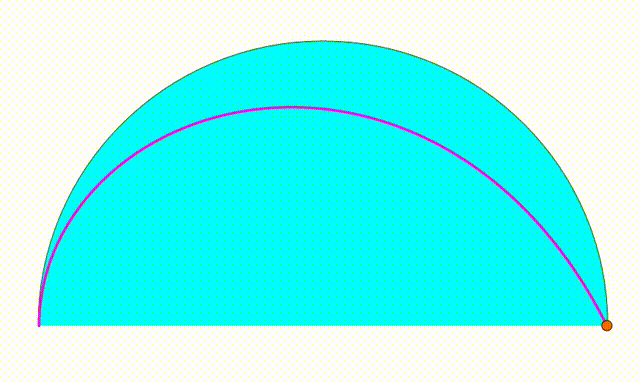Dynamic Geometry: P77
 The diagram shows a black semicircle with radius
. The cyan and green semicircles are tangent to each other and internally tangent to the black semicircle. They are growing and shrinking freely so that the sum of their radius is always equal to
. We draw a red vertical segment using their tangency point. At last we inscribed two yellow circles so they are tangent to the red line, to the black semicircle and to one of the two bottom semicircles. The center of one yellow circle (orange point) traces a
locus
(purple curve). The area bounded by the purple curve and the black semicirle's diameter can be expressed as
, where
and
are coprime positive integers. Find
.
The diagram shows a black semicircle with radius
. The cyan and green semicircles are tangent to each other and internally tangent to the black semicircle. They are growing and shrinking freely so that the sum of their radius is always equal to
. We draw a red vertical segment using their tangency point. At last we inscribed two yellow circles so they are tangent to the red line, to the black semicircle and to one of the two bottom semicircles. The center of one yellow circle (orange point) traces a
locus
(purple curve). The area bounded by the purple curve and the black semicirle's diameter can be expressed as
, where
and
are coprime positive integers. Find
.
The answer is 1.
This section requires Javascript.
You are seeing this because something didn't load right. We suggest you, (a) try
refreshing the page, (b) enabling javascript if it is disabled on your browser and,
finally, (c)
loading the
non-javascript version of this page
. We're sorry about the hassle.
Let the center of the unit semicircle be O ( 0 , 0 ) , the origin of the x y -plane, the center of the right yellow circle or an arbitrary point on the locus be P ( x , y ) and the radius r 1 , and the center and radius of the green circle be Q and r , the foot of the vertical red line be N , and P M be perpendicular to the x -axis.
By Pythagorean theorem ,
M Q 2 + P M 2 ( N Q − N M ) 2 + P M 2 ( r − r 1 ) 2 + y 2 ⟹ y 2 = P Q 2 = P Q 2 = ( r + r 1 ) 2 = ( r + r 1 ) 2 − ( r − r 1 ) 2 = 4 r 1 r
Also
O M 2 + P M 2 ( O N + N M ) 2 + y 2 ( 1 − 2 r + r 1 ) 2 + 4 r 1 r ( 1 + r 1 ) 2 − 4 r ( 1 + r 1 ) + 4 r 2 + 4 r 1 r 2 r 1 − 4 r + 4 r 2 ⟹ r 1 y 2 ⟹ y = O P 2 = ( 1 − r 1 ) 2 = 1 − 2 r 1 + r 1 2 = 1 − 2 r 1 + r 1 2 = − 2 r 1 = r − r 2 = 4 r 1 r = 4 r 2 ( 1 − r ) = 2 r 1 − r
Note that x = O M = O N + N M = 1 − 2 r + r 1 = 1 − 2 r + r − r 2 = 1 − r − r 2 . The area under the locus is given by:
A = ∫ − 1 1 y d x = ∫ − 1 1 2 r 1 − r ⋅ d ( 1 − r − r 2 ) = ∫ 0 1 2 r ( 1 + 2 r ) 1 − r d r = ∫ 0 1 4 ( 1 − u 2 ) ( 3 − 2 u 2 ) u 2 d u = ∫ 0 1 4 ( 3 u 2 − 5 u 4 + 2 u 6 ) d u = 4 − 4 + 7 8 = 7 8 Let u 2 = 1 − r ⟹ 2 u d u = − d r
Therefore p − q = 8 − 7 = 1 .